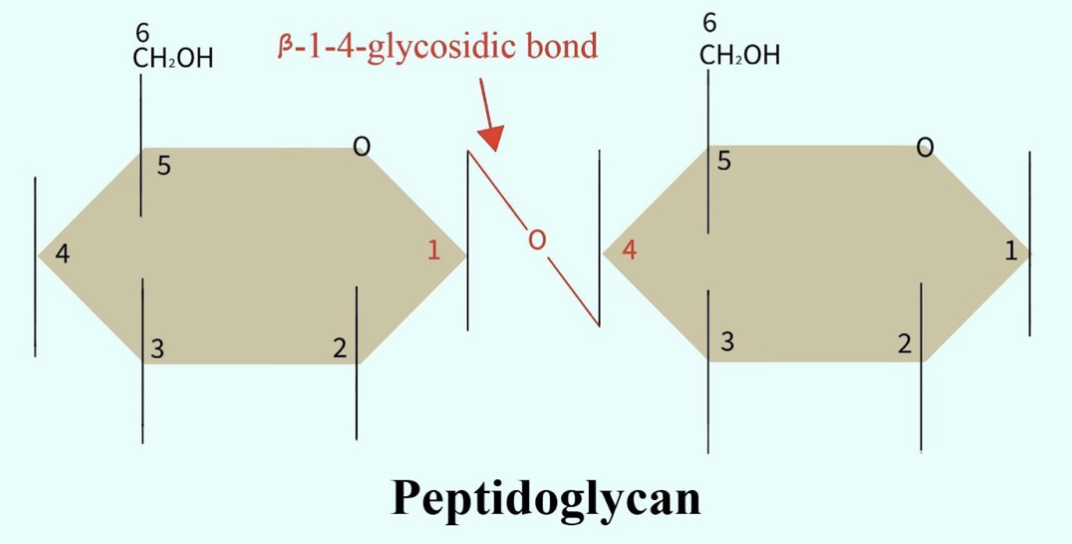
Bacteria cell wall is composed of peptidoglycan, a complex of oligosaccharides and proteins. The oligosaccharide component consists of _____________.
(a) Linear chain of alternating NAG and NAM linked by
(b) Linear chain of alternating NAG and NAM linked by
(c) Linear chain of glucose linked by
(d) Linear chain of glucose linked by
Answer
480.9k+ views
Hint: A polymer composed of sugars and amino acids that forms a mesh-like layer outside the plasma membrane of most bacteria, forming the cell wall, is peptidoglycan or murein.
Complete answer:
The oligosaccharide part of the bacterial cell wall consists of alternating NAG and NAM linear chains bound by
Additional information: In Gram-positive bacteria (20 to 80 nanometers) , the peptidoglycan layer is considerably thicker than in Gram-negative bacteria (7 to 8 nanometers). The peptidoglycan forms about 40 to 90 percent of the cell wall's dry weight of Gram-positive bacteria, depending on pH growth conditions, but only about 10 percent of Gram-negative strains.

The presence of high levels of peptidoglycan is thus the primary determinant of Gram-positive bacterial characterization. It is important for attachment roles and serotyping purposes in Gram-positive strains. Particles of approximately 2 nm will pass through the peptidoglycan in both Gram-positive and Gram-negative bacteria.
So, the correct answer is ‘Linear chain of alternating NAG and NAM linked by
Note: In the bacterial cell wall, peptidoglycan plays a structural role, giving structural strength as well as counteracting the cytoplasm's osmotic pressure. In binary fission during bacterial cell replication, peptidoglycan is also involved. A peptide chain of three to five amino acids is bound to the N-acetylmuramic acid. You may cross-link the peptide chain to the peptide chain of another strand that forms a 3D mesh-like sheet.
Complete answer:
The oligosaccharide part of the bacterial cell wall consists of alternating NAG and NAM linear chains bound by
Additional information: In Gram-positive bacteria (20 to 80 nanometers) , the peptidoglycan layer is considerably thicker than in Gram-negative bacteria (7 to 8 nanometers). The peptidoglycan forms about 40 to 90 percent of the cell wall's dry weight of Gram-positive bacteria, depending on pH growth conditions, but only about 10 percent of Gram-negative strains.

The presence of high levels of peptidoglycan is thus the primary determinant of Gram-positive bacterial characterization. It is important for attachment roles and serotyping purposes in Gram-positive strains. Particles of approximately 2 nm will pass through the peptidoglycan in both Gram-positive and Gram-negative bacteria.
So, the correct answer is ‘Linear chain of alternating NAG and NAM linked by
Note: In the bacterial cell wall, peptidoglycan plays a structural role, giving structural strength as well as counteracting the cytoplasm's osmotic pressure. In binary fission during bacterial cell replication, peptidoglycan is also involved. A peptide chain of three to five amino acids is bound to the N-acetylmuramic acid. You may cross-link the peptide chain to the peptide chain of another strand that forms a 3D mesh-like sheet.
Latest Vedantu courses for you
Grade 10 | MAHARASHTRABOARD | SCHOOL | English
Vedantu 10 Maharashtra Pro Lite (2025-26)
School Full course for MAHARASHTRABOARD students
₹33,300 per year
Recently Updated Pages
Master Class 9 General Knowledge: Engaging Questions & Answers for Success

Master Class 9 English: Engaging Questions & Answers for Success

Master Class 9 Science: Engaging Questions & Answers for Success

Master Class 9 Social Science: Engaging Questions & Answers for Success

Master Class 9 Maths: Engaging Questions & Answers for Success

Class 9 Question and Answer - Your Ultimate Solutions Guide

Trending doubts
State and prove Bernoullis theorem class 11 physics CBSE

What are Quantum numbers Explain the quantum number class 11 chemistry CBSE

Who built the Grand Trunk Road AChandragupta Maurya class 11 social science CBSE

1 ton equals to A 100 kg B 1000 kg C 10 kg D 10000 class 11 physics CBSE

State the laws of reflection of light

One Metric ton is equal to kg A 10000 B 1000 C 100 class 11 physics CBSE




